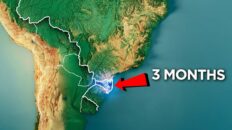Saudi Arabia’s NEOM smart city project has gotten a lot of attention lately, but Japan has a handful of smart cities in development that are every bit as innovative and weird and… maybe problematic? Especially a project called The Woven City by Toyota. Let’s take a look at them.
TRANSCRIPT:
I could start talking about the NEOM updates and maybe – maaaybe – dip a little into why the Saudis are doing this
Last year, I covered Saudi Arabia’s NEOM project, also known as The Line. It’s a hotly debated topic with strong opinions about its ethics, its logic, and potential for success.
Regardless, construction has begun on this project, which has somehow gotten even weirder than before. What was once just a strangely shaped city with multiple levels of interaction for living, working, and transportation, has become a giant mirrored wall as tall as the Empire State Building with 3D communities and… Are those floating trees?
You know your idea is ludicrous when you have to scream in bold letters on your website’s homepage: NEOM Is Real.
No, really, we’re gonna do this, guys! We’re really this crazy!
By the way, if you needed more evidence that fossil fuels are on the way out, this is the length that Saudi Arabia is going to to rebrand themselves as a tech center instead of a petrostate. There is this much writing on the wall.
Now, I’m as skeptical as the next guy about the viability of this project, having said that, there’s a lot of things that they’re trying in terms of sustainability and efficiency that I think are really interesting and, of course, would love to see succeed.
But it definitely starts a conversation about smart cities, how cities work and how they should work. The whole idea of starting a city from scratch using modern technology and construction, you know, throwing off the old ideas and trying something new.
And NEOM isn’t the only city in the world trying new things. In fact Japan has a handful of smart cities in the works. Let’s talk about one of them.
Global Aging and Urbanization
And with any luck, I’ll be one of them.
Assuming I make it…
By 2050, one-in-five people worldwide will be a senior citizen. Or close to it, depending on your local definition. At the same time, more people will be moving into cities.
Mo Cities, Mo Problems
Let’s start with traffic. In 2022, the average London driver spent 156 hours delayed in traffic. There are actually eleven other cities where drivers spent over 100 hours stuck in traffic, and a lot more cities in the high double digits.
This also leads to health concerns from poor air quality. You might remember those pictures showing cleaner air in cities during the COVID lockdowns, well… that’s all over.
Caregiving Crisis
That’s more than the rest of the world can expect in the next 30 years.
On top of that, Japan’s birth rate has been falling steadily. 2022 set a record low.
So… technology to the rescue. Luckily they’ve got a lot of it.
At CES 2020, Toyota Motor Corporation announced plans to build what they call the Woven City – a “living laboratory” for testing smart city technology.
The purpose of Woven City is “Well-being for all,” and that includes the elderly.
Japan’s Smart Towns
I’ll get to details in a moment, but the Woven City isn’t like a first-time idea in Japan, there are actually a lot of projects like this that Japan calls Sustainable Smart Towns, or SSTs.
They’ve been doing this not just for all the reasons I just mentioned but also as technology incubators for some of their major corporations.
Panasonic opened the Fujisawa Sustainable Smart Town to 100 families in 2014. Fujisawa is a city of 439,000 people, so what Panasonic has crafted is basically a high-tech neighborhood.
That neighborhood is now home to 2000 people. Panasonic opened a similar town in 2018 and another in 2022. All three run on renewable energy and have been designed with inter-generational families in mind.
Another city called Aizuwakamatsu is also set to host a smart city prototype. It doesn’t look like much right now, basically an office and some security cameras.
But a number of Japanese corporations have signed on as investors, including Accenture, Nissan, Epson, a printing firm namd Toppan Inc, and the University of Aizu. So something’s going on there.
Aizuwakamatsu, by the way, is the home of a famous samurai castle.
Toyota and Mobility
And now, Toyota has their smart sustainable town in the works. SSTs are popular with car manufacturers because they’re looking to stay relevant as technology changes. And Toyota’s no exception.
Except when it comes to EVs of course.
You can find the link below, but the TLDR; is Toyota is rebranding itself as a Mobility Company.
They’re focusing on people and using their manufacturing mojo to move bodies, products, and information around. I know the mobility thing sounds vague, but it’s all the rage in car companies these days.
Tesla has used mobility as a blanket term for EV and autonomous driving. Google talks about improving “access to mobility” with Waymo.
And in a way… you could make the argument that the whole smart city movement is like a reaction to the virtualization of everyday life.
It’s like Toyota and the other companies are trying to remind us to get outside, breath the air. Technology has made it possible to do most of what we want electronically, but the meat bags we live in still have to function offline.
Built from Scratch
So, how will Toyota’s Woven City accomplish this? Well, unlike Panasonic’s Sustainable Smart Towns or the smart additions to Aizuwakamatsu, Woven City is starting from scratch. Sort of.
Toyota is building on land that was the site of the Higashi Fuji Plant, where cars were built until 2020. The 175 acre site is located in Susono, a city of about 51,000 people.
And the view will be *MWAH!* Every piece of media I’ve seen about Woven City has shown off Mount Fuji. Toyota had inspiration in mind when they picked the location.
Four Paths
And the people who live there will be able to take in this view from three different pathways. The first will be for autonomous vehicles, the second for pedestrians and small vehicles, and the third for pedestrians only.
At CES 2020, the architect of Woven City, Bjarke Ingels, described the paths as “separate forms of mobility.”
And emphasis will be put on the pedestrian experience. You’ll be able to walk most places in the city without ever leaving a park.
In fact, the Woven City logo illustrates how the parklike roads surround a central hub.
But there is actually a fourth type of path most citizens will use, but never see. And that’s the city’s logistics path, which will be underground.
This way cargo and goods can be delivered directly to buildings without taking up space in the streets.
And deliveries around town will be shuttled by autonomous delivery vehicles so anything you might need can arrive at your building in minutes.
Hydrogen Fuel Cells
And because this is Toyota, all this will be powered… wait for it… By hydrogen!
Toyota’s just all-in on hydrogen – does hydrogen have Toyota’s mother in a basement somewhere?
Now I will say, hydrogen fuel cells have their uses, and there’s an argument to be made that it makes more sense in a local, ground-up infrastructure where it can be extracted and stored without having to transport it around the country.
And I guess it makes sense to store energy in hydrogen for the times when the sun’s not out and the wind doesn’t blow.
Regardless, it’s better than burning fossil fuels, so points I guess.
Healthy Eating
Now you might be thinking, hey, this doesn’t sound as dystopian as a lot of other smart city projects I’ve heard of…
Let’s talk about the food!
Like I said earlier, Toyota calls the Woven City a “living laboratory” and you know what you find in laboratories… lab rats.
A big part of the Woven City pitch is a focus on the health of its citizens, so to that end, they’ve created a special diet for them.
And every house has a giant water bottle with the little ball at the end.
Nissin Foods has created a “new diet” for Woven City “that allows people to enjoy a Complete Nutrition Meal.” Just in case you were wondering what their plans are for that elderly population.
All joking aside, they want to build a health platform for their citizens that provides healthy food and health monitoring to prevent and treat diseases. The world’s most high tech life alert.
Health Monitoring
All of which is connected in a vast Internet of Things. Security cameras, air conditioning systems, even those smart fridges I mentioned will all be connected. And then Artificial Intelligence will take all that data and decide what should be done for the residents.
Toyota has its own take on the role it wants AI to play. Instead of saying “AI” they use the term IA: Intelligence Amplified. This is not a new concept, but something Toyota has been working on for years.
In fact, if you want a preview of what living in Woven City might be like, I’ll put a link down in the description, it’s a video from the Toyota Research Institute, specifically TRI Robotics.
In it they talk about how robots can help care for the elderly. In keeping them safe, keeping their surroundings secure, and just generally making life easier.
And this, of course, is the stated purpose of the entire project. Regardless of how -eh- it might all feel, the goal is to automate caregiving so the children and grandchildren will have extra time to share doing the things that really matter.
Privacy Concerns
But if you have concerns around privacy, you’re not alone.
The United Nations Human Rights Office has a lot to say on the subject.
One report on a smart city project in South Korea pointed to areas of special concern. Including the privacy of health and social security data, privacy for HIV and AIDS-positive persons, and privacy in the workplace.
That last one is especially relevant to Woven City. Many of the residents are expected to be Toyota employees and their families.
Woven City, and smart city projects around the world, will have to strike a balance between collecting data and ensuring privacy for its citizens.
And the fact that these cities are often built by private corporations and not elected governments is a little disconcerting. Company towns don’t exactly have the best history.
Progress and Funding
So where are things with the Woven City? Well they broke ground on February 23, 2021. They released a time-lapse video that celebrated the one-year anniversary last year. It mostly shows dirt being shoved around.
But it’s very high-tech dirt.
Toyota hasn’t made a completion date public. They also haven’t said how much it will cost.
But here’s a clue. Toyota announced plans to issue Woven Planet Bonds back in 2021.
Other Smart Cities
Of course, that’s peanuts to the total investment being made in smart cities around the world. I talked about NEOM earlier, that’s a $500 billion project.
But there are others. The 48 hotels of the Red Sea Project, for example, plan to use “cutting-edge technology”, “smart digital destination management”, and “IoT sensors” to take care of guests.
In 2021, Red Sea merged with AMAALA, another multi-billion dollar project with high-tech features.
Over here in North America you’ve got Peachtree Corners, Georgia.
Redevelopment efforts there included construction of Curiosity Lab, a “living laboratory” to test “intelligent mobility and smart city technology.”
Why do companies think people want to live in a laboratory?
Lessons from Quayside
By the way, some of these smart town projects don’t work out. Like Google’s Quayside (Key-Side) project.
There’s an article by Karrie Jacobs in the MIT Technology Review, where she talked about the culture clash between Toronto and Google. “Almost every person I spoke with…used the word ‘hubris’ or ‘arrogance’ to describe the company’s attitude,”
Toyota has made lots of statements about putting people first in Woven City, but Google said the same about Quayside.
The New Age of Company Towns?
Considering that Toyota already owns the land where they’re building the Woven City, they probably won’t have the same kind of issues.
We’ll probably see the first hundred residents move in in a few years, with the total population of 2000 not long after that.
But maybe the biggest question is… Is this the trend? Are corporate-run smart cities going to pop up around the world?
Because that wouldn’t be a new phenomenon.
I mentioned company towns earlier, these used to be the norm until about 100 years ago.
The US was lousy with company towns, especially around mining and logging industries. In Britain, these were called model villages. And some of these places were pretty horrific.
I mean, if you hate how much control your job has over you now, imagine if they controlled when you eat and sleep, who you hang out with, where you hang out, what you can wear, whether or not you can drink, what kind of music you listen to, and every item you purchase comes from them and they can charge you whatever they want.
Knowing Better has a great video about the history of company towns, I’ll link it below but essentially some of these places ensured that their workers stayed permanently in debt to them, creating a kind of slavery.
Now, is it fair to paint the Woven City with that brush? Who knows. I guess we’ll see.
In the best case scenario, Woven City and other smart towns will pioneer new technologies and systems that will filter into all the other cities in the world and make all our lives better. Maybe in 100 years, this kind of connectedness will be normal and people will think of how we live like its the wild wild west.
But I guess time will tell. Let me know what you think in the comments.




Add comment